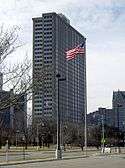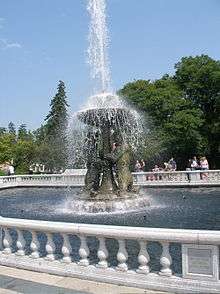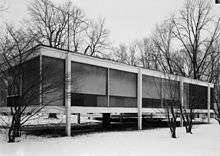Lafayette Park, Detroit
|
Mies van der Rohe Residential District, Lafayette Park | |
|
View of Lafayette Park from Windsor, Ontario, Canada, 2007 | |
  | |
| Location | Roughly bounded by Lafayette Ave., Rivard, Antietam, and Orleans Sts., Detroit |
|---|---|
| Coordinates | 42°20′22″N 83°01′55″W / 42.3394°N 83.0319°WCoordinates: 42°20′22″N 83°01′55″W / 42.3394°N 83.0319°W |
| Area | 46 acres (19 ha) |
| Built | 1956 |
| Architect | Ludwig Mies van der Rohe, Ludwig Hilberseimer, et al. |
| Architectural style | International style |
| NRHP Reference # | 96000809 |
| Significant dates | |
| Added to NRHP | August 1, 1996[1] |
| Designated NHLD | July 21, 2015 |
Lafayette Park is a high rise residential neighborhood east of Downtown Detroit. The area is part of the Mies van der Rohe Residential District listed in the National Register of Historic Places.[2] In 2015 it was designated a National Historic Landmark District. Lafayette Park is located on the city's lower east side directly south of the Eastern Market Historic District.
Description
The 78-acre (32 ha) development was originally planned as Gratiot Park in 1946 to replace the Black Bottom neighborhood, considered a blighted slum and long named for its rich black topsoil.[3] Originally the project was assigned to Minoru Yamasaki, but since no local developer would touch it, efforts were made to bring in Herb Greenwalt from Chicago who had worked with Mies on several highrise apartment buildings along Lakeshore. Herb assented but indicated that he would only work with his architect and friend, Mies van der Rohe who had transformend the Armor Institute into the Illinois Institute of Technology. Walter Reuther and those involve were thrilled because it was their intention to have the very best design. And so it was planned by Ludwig Mies van der Rohe being the Architect, and his staff Ludwig Hilberseimer being the City Planner and Alfred Caldwell being the Landscape architect, the complex is a collection of one and two-story townhomes, Some low rise apartment buildings and a small neighborhood shopping center known as Towers Plaza, and five high-rises set adjacent to a 19-acre municipally-operated park.[4]
In order to understand the extreme significance of the work one has to remember the sequence of the development of Modern Architecture. With the advent of the 20th Century steel became available for the construction of buildings and Louis Sullivan began to build Steel Framed buildings as opposed to thick masonry walls. Sullivan noticed that the steel frames under construction were more interesting and beautiful. And so he became the first Modern Architect and wrote a thesis on the theory of design named "the Kindergarden Chats" It was written for young architects to inspire them into thinking about the essence of design. He explored the concepts of form and function and insited that the form had to express the function and they were interrelated. While it is romantically written it was the seminal idea that something new was to be created relating to expression. It should be remembered that Frank Lloyd Wright worked for Louis Sullivan and became his Chief Draftsman and broke off on his own but referred to Louis as his Lieber Meister. Frank became fashionable and lectured and was hired by Mayma Cheney and her Husband and being college educated at the University of Michigan in Library Science was very instrumental in inspiring him to move away from the taller Victorian styles and designing his first low slung building for a residence. It was shocking. And Frank had hired a wonderful draftswoman, Marion Mahony Griffin, who began drawing stunningly beautiful ink line perspectives of his current work which were published as the Wasmuth Folio with plans and perspectives of the first 20 years of his career.
The Publishing of the Folio in Berlin was met with awe and inspiration and the European Architects took had begun philosophizing about design as well. The Bauhaus was formed and Mies became the head of the school in 1930 ti 1933 and many Notables taught there such as Marcel Breuer, Lionel Feininger, Anni Albers, Josef Albers, Herbert Bayer, Marcel Breuer, Lyonel Feininger, Naum Gabo, Ludwig Hilberseimer, Johannes Itten, Wassily Kandinsky, Paul Klee, László Moholy-Nagy, Piet Mondrian. Because of the Nazi aspersions toward the school and growing ambitions of domination many fled to America. By mid 20th Century it was well established that Frank Lloyd Wright, Mies van der Rohe, and Le Corbusier were the finest Modern Architects in the world and that assessment continues to this day. Lafayette Park is the product of a master of Modern Architecture, the inventor of the steel and glass skyscraper and precision articulation. Lafayette Park is the largest collection of Mies' work in the world and this was America's first and remains the foremost, and most successful Urban Renewal Project created so far.
It should be noted that Frank Lloyd Wright admired Oriental architecture, and the only image found in his studio was of the Potala in Tibet. He loved the use of massive masonry buildings and was a master of the selection and pattern of laying brick and stone. Though he was a collector of Hokusai prints China was his inspiration. But clearly Mies was more interested in Japanese architecture of post and beam construction and particularly the Imperial Palace. The Lafayette Park townhouses are of post and beam construction with infill panels of glass rather than rice paper. But Mies used unpolished plate glass on occasion giving it a similar quality of the paper. So the orderly rigor of the Imperial Palace with the black painted posts and beams are clearly the inspiration for Mies design. But instead of the palace for the Emperor, we have the Palace for the People. Perfectly Democratic and in harmony with Thomas Jefferson's notions.
It should also be noted that Herb Greenwalt was killed in an airplane accident while touring around Manhattan searching for places to develop there. So the project is essentially half complete. Upon Herb's death and Walter Reuther's Death the project fell into the hands of local architects and the dichotomy is distressing because the low rise apartment buildings bear absolutely no relationship architecturally and hence illustrate the extreme importance of the relationship of the designer and the developer. The remainder is vastly inferior.
The Steel Framed residential buildings of Lafayette Park are classic examples of Mies' International Style, with their simplicity, clean proportions, and expansive glazings with structural materials being expressed and the use of aluminum for the window frames.
The Pavilion Apartments were glazed with huge windows approximately 9' wide giving great panoramic vistas. The mechanical Pentouse is glazed in the same fashion giving it a high tech look since you can see the pipes and ducts from below. The Twin towers had narrow windows similar to the Lakes Shore Apartments except that they are of Aluminum framing, and the Seagram Building on Park Avenue on Manhattan which is done in bronze.
It should also be noticed that 1300 Lafayette was designed by Gunnar Birkerts and was noted for having a jazz rhythm with its structural columns. While Gunnar was not an advocate of Mies, it does reveal another expression in Modern Architecture. The complex is located roughly halfway between downtown and Chene Park, and are also close to Belle Isle and the MacArthur Bridge. There is also easy access to I-375, Gratiot Avenue, and Jefferson Avenue. Lafayette Park is also near the architecturally significant St. Joseph's Catholic Church, and the Eastern Market Historic District and Christ Church Episcopal by Gordon Lloyd Detroit's preeminent Architect in the 1860's to the turn of the century.
Constituent buildings
There are 186 one and two-story cooperative townhouses on 18 acres west of the park, built between 1958 and 1960.[6] The complex also includes:
| Building Name | Floors | Year Completed |
|---|---|---|
| 1300 Lafayette East Cooperative by Gunnar Birkerts | 29 | 1961 |
| Lafayette Pavilion Apartments by Mies | 22 | 1958 |
| Lafayette Towers Apartments East by Mies | 22 | 1963 |
| Lafayette Towers Apartments West by Mies | 22 | 1963 |
| The Windsor Tower | 21 | 1965 |
Education
The community is zoned to Detroit Public Schools.
Residents are zoned to Chrysler Elementary School, Created for the children of Lafayette Park and the finest grade school in the DPS system.[7] Bunche K-8 for middle school,[8] and Martin Luther King High School.[9] Previously Duffield K-8 served the community for middle school.[10]
Detroit Public Library operates the Elmwood Park Branch Library at 550 Chene. The branch first opened on April 21, 1975 in the Elmwood Park Plaza. The first owners of the shopping plaza included the branch after residents insisted on the inclusion of the library. As of 2009 it is the only branch located in a shopping plaza.[11]
Gallery
 Lafayette Park Detroit includes shopping
Lafayette Park Detroit includes shopping 1300 Lafayette East Cooperative in the foreground, Lafayette Pavilion Apartments in the background
1300 Lafayette East Cooperative in the foreground, Lafayette Pavilion Apartments in the background Lafayette Park's constituent apartment buildings
Lafayette Park's constituent apartment buildings 1300 Lafayette East Cooperative
1300 Lafayette East Cooperative 1300 Lafayette East
1300 Lafayette East

See also
- List of National Historic Landmarks in Michigan
- National Register of Historic Places listings in Detroit, Michigan
Notes
- ↑ National Park Service (2009-03-13). "National Register Information System". National Register of Historic Places. National Park Service.
- ↑ Vitullo-Martin, Julio, with photo by Mike Russell (December 22, 2007).The Biggest Mies Collection: His Lafayette Park residential development thrives in Detroit.The Wall Street Journal. Retrieved on January 1, 2009.
- ↑ detroitexpatroit (2011-01-24). "http://detroiturbandesign.blogspot.com/2011/01/005-lafayette-park-example-in.html". Detroiturbandesign.blogspot.com. Retrieved 2013-11-02. External link in
|title=(help) - ↑ http://www.miessociety.org/legacy/projects/lafayette-park/ Accessed 2/27/12
- ↑ The source of this writing stems from studying Architectural history at the University of Michigan's School of Architecture and Design, and personal observations since I have been aware of this work since the 1960's and have lived here, employing the principles of the Secretaries Standards for Historic Restoration, and also having also worked on the Restoration of Independence Hall aka the Pennsylvania State House in Philadelphia with Lee Nelson who was active in establishing the current standards for Historic Restoration.
- ↑ City of Detroit, Proposed Lafayette Park/Mies van der Rohe Historic District Final Report 2002
- ↑ "Elementary School Boundary Map." Detroit Public Schools. Retrieved on October 20, 2009.
- ↑ "Middle School Boundaries - 2012/13 School Year." (Archive) Detroit Public Schools. Retrieved on November 1, 2012.
- ↑ "High School Boundary Map." Detroit Public Schools. Retrieved on October 20, 2009.
- ↑ "Middle School Boundary Map." Detroit Public Schools. Retrieved on November 7, 2009.
- ↑ "Elmwood Park Branch Library." Detroit Public Library. Retrieved on April 19, 2009.
References
- Waldheim, Charles (2004). Case: Lafayette Park Detroit. Prestel Publishing. ISBN 978-3-7913-3044-0.
- Hill, Eric J. and John Gallagher (2002). AIA Detroit: The American Institute of Architects Guide to Detroit Architecture. Wayne State University Press. ISBN 0-8143-3120-3.
- Garvin, Alexander (2002). The American City: What Works What Doesn't (2nd Ed.). McGraw Hill. ISBN 978-0-07-137367-8.
External links
| Wikimedia Commons has media related to Lafayette Park. |
- Google Maps location of the Lafayette Park
- Kathy Toth Flickr gallery: Photographs of Lafayette Park
- Ktoth.ca: Photographs of Lafayette Park




